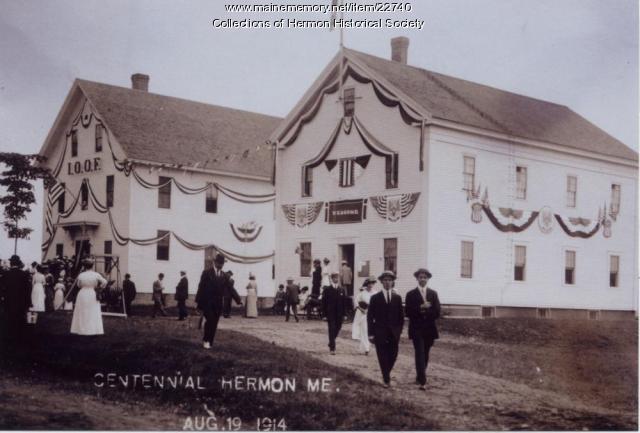Keywords: Congregational
Item 79525
Dixfield Congregational Church, High Street, Dixfield, 2006
Contributed by: Dixfield Historical Society Date: circa 2006 Location: Dixfield Media: Postcard
Item 27635
Hampden Congregational Church, Hampden, 1893
Contributed by: Hampden Historical Society Date: 1893 Location: Hampden Media: Photographic print
Item 85930
187-195 Woodford Street, Portland, 1924
Owner in 1924: Woodford Congregational Parish Use: Dwelling
Item 85931
Assessor's Record, 191 Woodford Street, Portland, 1924
Owner in 1924: Woodford Congregational Parish Use: Stable
Item 111995
State Street Congregational Church alterations, Portland, 1892-1893
Contributed by: Maine Historical Society Date: 1892–1893 Location: Portland Client: State Street Congregational Church Architect: John Calvin Stevens
Item 116471
Congregational Church alterations, Winslow, 1951
Contributed by: Maine Historical Society Date: 1951 Location: Winslow Client: Winslow Congregational Church Architect: John Howard Stevens and John Calvin Stevens II Architects
Exhibit
Anshe Sfard, Portland's Early Chassidic Congregation
Chassidic Jews who came to Portland from Eastern Europe formed a congregation in the late 19th century and, in 1917, built a synagogue -- Anshe Sfard -- on Cumberland Avenue in Portland. By the early 1960s, the congregation was largely gone. The building was demolished in 1983.
Exhibit
Shaarey Tphiloh, Portland's Orthodox Synagogue
Shaarey Tphiloh was founded in 1904 by immigrants from Eastern Europe. While accommodating to American society, the Orthodox synagogue also has retained many of its traditions.
Site Page
View collections, facts, and contact information for this Contributing Partner.
Site Page
Presque Isle: The Star City - Presque Isle Congregational Church
"Today the official name is the Presque Isle Congregational Church. Sources: Vance, Melissa. "Presque Isle Congregational Church Claims Origins from…"
Story
Rev James Wells Appointment as Chaplain for Maine in Civil War
by David Woodward
Certificate for Rev. Wells commissioned by Gov. Israel Washburn Jr. to serve in Maine 11th Regiment
Story
Cantor Beth & Dr David Strassler: personal insights on life
by Biddeford Cultural & Heritage Center
The journey of a couple devoted to each other, their family, their community and their religion
Lesson Plan
Building Community/Community Buildings
Grade Level: 6-8
Content Area: Social Studies
Where do people gather? What defines a community? What buildings allow people to congregate to celebrate, learn, debate, vote, and take part in all manner of community activities? Students will evaluate images and primary documents from throughout Maine’s history, and look at some of Maine’s earliest gathering spaces and organizations, and how many communities established themselves around certain types of buildings. Students will make connections between the community buildings of the past and the ways we express identity and create communities today.
Lesson Plan
Longfellow Studies: "The Jewish Cemetery at Newport"
Grade Level: 6-8, 9-12
Content Area: English Language Arts, Social Studies
Longfellow's poem "The Jewish Cemetery at Newport" opens up the issue of the earliest history of the Jews in America, and the significant roles they played as businessmen and later benefactors to the greater community. The history of the building itself is notable in terms of early American architecture, its having been designed, apparently gratis, by the most noted architect of the day. Furthermore, the poem traces the history of Newport as kind of a microcosm of New England commercial cities before the industrialization boom. For almost any age student the poem could be used to open up interest in local cemeteries, which are almost always a wealth of curiousities and history. Longfellow and his friends enjoyed exploring cemeteries, and today our little local cemeteries can be used to teach little local histories and parts of the big picture as well.
Henry Wadsworth Longfellow visited the Jewish cemetery in Newport, RI on July 9, 1852. His popular poem about the site, published two years later, was certainly a sympathetic portrayal of the place and its people. In addition to Victorian romantic musings about the "Hebrews in their graves," Longfellow includes in this poem references to the historic persecution of the Jews, as well as very specific references to their religious practices.
Since the cemetery and the nearby synagogue were restored and protected with an infusion of funding just a couple years after Longfellow's visit, and later a congregation again assembled, his gloomy predictions about the place proved false (never mind the conclusion of the poem, "And the dead nations never rise again!"). Nevertheless, it is a fascinating poem, and an interesting window into the history of the nation's oldest extant synagogue.





















